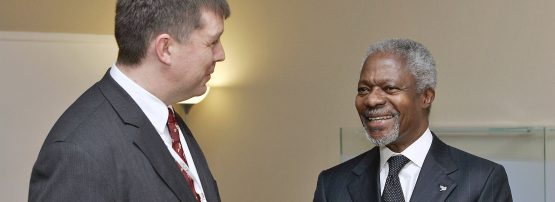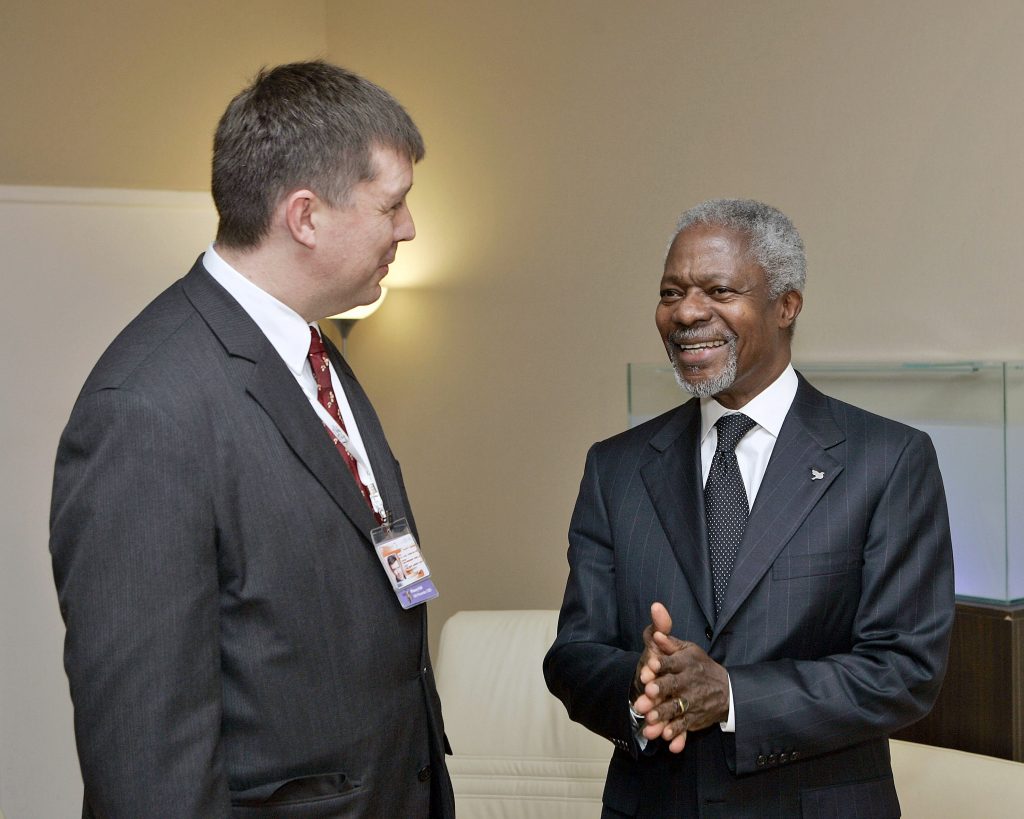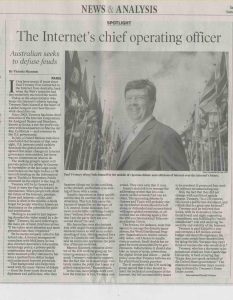
It’s a spring morning in New York, March 2004. Paul Twomey, a then 40-something, Australian CEO of a relatively new not-for profit organization based in the US, ICANN, is clutching three maps as he waits patiently in a foyer to meet the United Nations Secretary-General Kofi Annan.
The two are due to discuss the first phase of the World Summit on the Information Society (WSIS), convened with world leaders from governments, civil society and business sectors of 175 economies to discuss and agree on the future governance of the Internet.
“In the early days of Internet governance discussions, many governments thought it was their role to control the Internet. And they certainly didn’t see any role for this new international multistakeholder organization,” remembers Paul, adding that the meeting with the Secretary-General was an opportunity to gain a powerful ally. And the key to doing so was the maps.
“I thought, ‘How am I going to convey the complexity of the Internet and the role of the technical community in its governance in 30 minutes?’,” recalls Paul. “Maps were how.”
The first map he showed Mr Annan was a geographical map of the world displaying political boundaries. “I remember putting it down and explaining to him how it showed the world according to foreign ministries, and him glancing at his deputy with a look of ‘Why is this man here wasting my time?,” chuckles Paul.
The second map was another map of the world, but this one showed all the international telecommunication and submarine cables. “I said, ‘This is the map of big telcos — this is how they and the ITU (International Telecommunication Union) see the world. Big investments and government regulation’.”
Paul remembers Mr Annan looking at this pretty closely, but it was the third map, a map of the Internet networks, which really got his attention.
“I said, ‘This is the Internet —there are no geographic boundaries. The challenge you and I have — I admit it was a bit presumptuous of me — is how we make this map work with the first one.’
Following the meeting the Secretary-General was determined that the Internet was not going to be broken on his watch. “He and his deputy said several times to me and other members of the Internet community that they did not want WSIS to be seen as a threat that the United Nations or its family of organizations should take over from the technical bodies now running the Internet. Annan made this point in the media as well.”

From deregulation to national strategies
Explaining the technical and nuanced concepts of the Internet to people in power has been ‘part of the job’ for Paul since the late-80s early-90s when at McKinsey and Company he was involved in the deregulation of the telecommunications markets in Australia and the subsequent merger of Telecom Australia and the Overseas Telecommunication Commission (OTC) into Australia’s largest telco, Telstra.
He was then recruited by the Australian Trade Commission to be the head of strategy and then of European operations. During this role he promoted the Australian IT industry, including at the huge CeBIT fair. But it was his time as Chief Executive at the newly formed Australian National Office for the Information Economy (NOIE) where he admits he was able to make the greatest impact in the development of the Internet in Australia.
“NOIE’s objective was to develop a national strategy to improve the economy using the growing popularity of the Internet in Australia,” explains Paul. “It involved lots of speaking to and coordinating with industry bodies, companies, the federal cabinet, and various levels of state and federal government; plenty of econometric work on what was the impact of Internet uptake; and identifying the mistakes that other economies had made so we didn’t repeat them.
“We figured, if the strategy could double the uptake of the Internet and the growth rates of that period from the late 90s into the early 2000s, that the GDP impact would be about the size of Singapore on the Australian economy. And I suspect a fair amount of it happened.”
Other local achievements that stemmed from NOIE included: developing and implementing a national strategy for the information economy, and coordinating with the state governments through the Online Council; developing the self-regulation model for auDA; amending several policies and legislations to facilitate electronic commerce, including the personal data protection legislation and the Electronic Transactions Act; coordinating the law enforcement and revenue agencies’ responses to the Internet economy, including amending Australia’s encryption and interception policies to encompass Internet communications; and laying the foundation of the recently implemented electronic health records system.
“It’s bemusing to think that it’s taken almost 20 years to implement the e-health project — the problem was that opt-in didn’t work; opt-out was clearly the thing that needed to happen,” concedes Paul. “At the same time, it shows how long it can take for these transformational projects to come to the fore.”
Punching above its weight
Internationally, the multistakeholder approach that Paul was employing at NOIE to inform and develop its strategies and amendments to policy and legislation attracted a lot of admirers, including Ira Magaziner, a member of the National Domestic Policy Council during the Clinton Administration and key author both of the Framework for Global E-Commerce and the Green Paper that led to the formation of ICANN.
“Ira had been invited to speak to the National E-Commerce Summit at Parliament House in April 1998. He got wind of what we were doing in forming NOIE and wanted to come to Australia and speak to and get the views of anyone who was involved in the national strategy,” recalls Paul who formed a close working relationship with Ira in the years to come. “It was because of that visit that we got engaged in the whole domain name, IP addressing space early in national policy”.
“Australia was the only economy to write a public, formal response to the Green Paper, a lot of which ended up in the White Paper. We essentially said, ‘Good idea but you need to internationalize this significantly and have open participation’.
“In essence, we helped to set the rules and principles around the coordination of the core of the Internet and how it is governed today. We ended up with a member on the first board of ICANN. I was the chair of its Government Advisory Committee for two terms and then I was CEO. And there’s been Australians on the board of ICANN pretty much for all its existence, all of which was and remains significant for the size of our economy and population.”
Education assists with making sure history doesn’t repeat itself
Paul credits much of these early career experiences to him becoming and acting as ICANN’s longest running CEO. But it’s his PhD in History, of all things, which he feels has played an equally important role in how he has approached Internet governance and policy making from the beginning.
“My thesis was on the search for a stable international economic and political order between 1919-1941 – the interwar period,” explains Paul. “It was a tumultuous time in history that gave us many lessons surrounding governance and diplomacy, including most notably the creation and failure of the League of Nations.
“I never thought it was particularly relevant during my early years, but when I was at ICANN there were a lot of similarities and lessons out of that period. All the debates in the UN, working alongside the ITU and other intergovernmental and multinational groups trying to answer how we, as a society, run something universally as the Internet in a world that’s not universal.
“The message I kept making all the time I was at ICANN, forever really, has been, ‘There’s a transit layer, which essentially governments have, for a long time, played a role in coordinating funding and regulating. There’s an application layer; that’s content, which governments have been worried about forever. And then there’s the protocol layer in the middle; that’s the global commons and foundation of the Internet. ICANN doesn’t have a view about content or transit. It’s only concerned about making sure the protocol layer doesn’t get broken.’”
Paul is grateful that governments came to understand this — as Mr Annan did following their meeting — devising ways to achieve what they wanted to achieve without fundamentally breaking the protocol layer.
“It’s a massive feather in the hat of the technical community, to have been able to successfully educate the world about the importance of not breaking the protocol layer, and the importance of using global standards.”
The views expressed by the authors of this blog are their own and do not necessarily reflect the views of APNIC. Please note a Code of Conduct applies to this blog.




